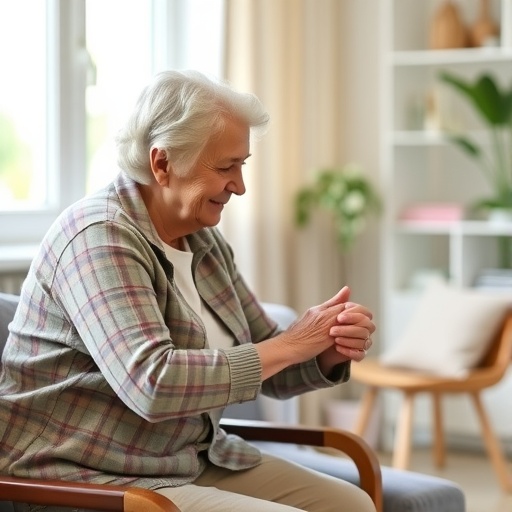
In a groundbreaking study that could reshape our understanding of health behaviors among elderly populations, researchers have delved deep into the realm of musculoskeletal pain prevention. Conducted by a team led by Habibi, alongside co-researchers Tavafian and Maghbouli, this research focuses on an often-overlooked demographic: the elderly residing in nursing homes. Drawing on the Health Belief Model, the researchers employed structural equation modeling to analyze factors influencing pain prevention behaviors in this vulnerable group.
As individuals age, the reality of musculoskeletal pain can become an overwhelming hurdle in daily life. This kind of pain not only hinders mobility but can also lead to reduced quality of life and increased dependency on caregivers. Yet, the factors that govern the behaviors aimed at preventing such pain have not been extensively studied. This research addresses that gap, tackling the complex interplay of personal beliefs, perceived threats, and preventive actions within nursing home residents.
The Health Belief Model serves as a critical analytical framework in this study. It proposes that a person’s likelihood of engaging in health-promoting behaviors—such as those aimed at preventing musculoskeletal pain—depends on their perceptions of the severity of the health issue, their vulnerability to it, and the benefits of taking preventive measures. By framing their research within this model, the authors elucidate the cognitive processes that may hinder or facilitate such behaviors among elderly individuals.
Utilizing structural equation modeling allowed the research team to establish robust relationships between various variables. Through this statistical approach, they could identify not just correlations but also the strength and direction of these relationships, providing a more nuanced understanding of the internal logic behind pain prevention behaviors. The study’s findings revealed several critical factors: perceived severity of pain, perceived susceptibility, self-efficacy, and the perceived benefits of engaging in preventive measures.
One of the standout findings was the role of perceived severity. Residents who viewed musculoskeletal pain as a significant threat were more likely to adopt preventive strategies. This highlights the importance of health education and communication strategies tailored to this demographic, aiming to raise awareness about the consequences of untreated musculoskeletal issues and the efficacy of prevention methods.
In addition to perceived severity, self-efficacy emerged as a crucial determinant of pain prevention behaviors. Elderly individuals who believed in their ability to perform activities that could mitigate pain—such as exercise and ergonomic adjustments—exhibited higher engagement in these beneficial behaviors. This finding underscores the necessity of reinforcing the confidence of nursing home residents in their capacity to manage their health.
The research also uncovered insights regarding the social support systems in place within nursing homes. Residents with stronger social connections and support reported a greater likelihood of engaging in preventive behaviors. This indicates that fostering an environment where residents encourage and support one another could enhance health outcomes and create a community centered around healthy living.
While the findings shed light on the determinants of pain prevention behaviors, they also underscore the need for tailored interventions. Future programs aimed at elderly populations should be grounded in the principles derived from this research. Health educators and nursing home staff must work collaboratively to design educational materials that resonate with residents, addressing both their fears and their motivations.
As the study progressed, the researchers faced challenges in recruitment and data collection, illustrative of the broader difficulties often encountered in gerontological research. Engaging elderly participants, particularly those in nursing homes, requires sensitivity and an understanding of their unique circumstances. The research team successfully navigated these challenges, demonstrating the importance of patience and resilience in academic investigations.
Interestingly, the study’s implications extend beyond nursing homes. With an aging global population, insights into musculoskeletal pain prevention can inform public health strategies across various settings. Community programs designed for older adults, whether in assisted living facilities or at home, can benefit from understanding the health beliefs that drive behavior change.
In addition, the research raises questions about the role of staff training in nursing homes. Equipping caregivers and health professionals with knowledge about the Health Belief Model could empower them to facilitate better health behaviors among residents. Furthermore, ongoing education and workshops focused on pain management strategies could foster a culture of health empowerment in these facilities.
This study comes at a vital time as the world grapples with the implications of an aging population and the increase in chronic conditions associated with aging. As healthcare systems adjust to this demographic shift, it is essential that research informs policy and practice that supports healthy aging. Insights from this research could serve as a springboard for further studies examining similar themes in diverse settings.
The findings of this research represent a clarion call to clinicians, caregivers, and policymakers alike. They elucidate the multilayered factors that contribute to health-related behavior in elderly populations and advocate for a comprehensive approach to pain prevention. By understanding what drives elderly residents towards or away from preventive actions, interventions can be more effectively tailored to meet their needs.
In summary, the pioneering work by Habibi and colleagues highlights the necessity for informed health strategies that cater to the specific needs and perceptions of elderly individuals living in nursing homes. Their findings empower stakeholders to rethink their approach to geriatric health care, fostering environments that prioritize autonomy, education, and proactive health management.
The continued investigation into this field promises to yield further insights into effective strategies for engagement and prevention among elderly populations. As our society shifts towards acknowledging the rights and needs of older adults, studies like this pave the way for an informed, compassionate approach to aging.
Moreover, the researchers emphasize the need for continued interdisciplinary collaboration, merging insights from psychology, geriatrics, and public health to develop holistic care models. This integrated approach is critical for breaking down silos and ensuring that elderly individuals receive comprehensive care that encompasses both physical and mental health.
In conclusion, as the geriatric population continues to grow, understanding their needs and behaviors around pain management becomes not just an academic exercise but a societal imperative. This study serves as a significant step forward, offering a blueprint for future research and practical approaches that will ultimately enhance the well-being of one of society’s most vulnerable groups.
Subject of Research: Factors influencing musculoskeletal pain prevention behaviors in elderly nursing home residents.
Article Title: Investigating effective factors on musculoskeletal pain prevention behaviors in the elderly population living in nursing homes, based on the health belief model: structural equation modeling approach.
Article References: Habibi, S., Tavafian, S.S., Maghbouli, R. et al. Investigating effective factors on musculoskeletal pain prevention behaviors in the elderly population living in nursing homes, based on the health belief model: structural equation modeling approach. BMC Geriatr 25, 685 (2025). https://doi.org/10.1186/s12877-025-06229-5
Image Credits: AI Generated
DOI: 10.1186/s12877-025-06229-5
Keywords: musculoskeletal pain, elderly population, nursing homes, health belief model, prevention behaviors, structural equation modeling, health education, self-efficacy, social support, chronic conditions.
Tags: analyzing health behaviors in nursing homescaregiver dependency and musculoskeletal painelderly mobility and quality of lifeelderly pain management strategiesfactors influencing pain preventionHealth Belief Model in seniorsmusculoskeletal pain prevention in elderlynursing home health behaviorsovercoming pain in aging populationspreventive health measures for seniorsresearch on elderly health issuesstructural equation modeling in health research




